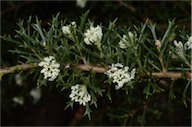Information about plants in flower this week
A news sheet prepared by a Gardens' volunteer, featuring the flowers, fruits and foliage of a selection of plants in the Australian National Botanic Gardens .
Numbers before each plant refer to temporary IFTW labels in the gardens.
Numbers in square brackets [ ] refer to garden bed Sections. Featured plants are in bold type.
View past issues of 'In Flower This Week'.
11 May - 24 May 2016
Today we will start our walk from the Visitors Information Centre (VIC) and finish in the Hakea section.
- On your left as you leave the VIC is Hypocalymma jessicae [Section 221] in a pot, a small bush with green foliage and pink flowers. It occurs in the wild in Western Australia (WA) between Albany and Esperance.
- Also in a pot on your left is Prostanthera densa [Section 221], or Villous Mintbush, a stiff, angular plant with pale green leaves and mauve flowers with orange markings. This plant, listed as vulnerable, is native to coastal New South Wales (NSW), north and south of Sydney.
- Bear left up the hill behind the café to see on your right Banksia spinulosa var. spinulosa [Section 109], or Hairpin Banksia, with large gold flowers, which is found in open forests and woodlands of the coasts and mountains of NSW and Queensland.
- Continue up the hill to the small triangular bed to see on your right Epacris calvertiana var. calvertiana [Section 17] native to coastal NSW, with cream bells on dark green foliage.
- Turn right to see on your right Chamelaucium ‘Cascade Brook’ [Section 17], or Geraldton Wax, endemic to WA, an open airy bush with masses of purplish-pink 5 petalled flowers with darker centres.
- Further along the road on your left is Brachyscome graminea [Section 123] or Grass Daisy, a light green groundcover with white daisy flowers with gold centres. It is widespread in south-eastern Australia, including Tasmania.
- On your right at the entrance to the Rock Garden is Grevillea lanigera [Section 15h] with grey-green foliage and long-lasting pink and cream flowers on a low bush. It is commonly known as Woolly Grevillea, and is endemic to Victoria and NSW.
- Further down on your right is Grevillea ‘Mason’s Hybrid’ [Section 15h], a spreading bush with large spider blooms of pink, red and orange. This hybrid arose as a seedling from seed collected from an upright glaucous form of Grevillea bipinnatifida. The other parent is presumed to be G. banksii.
- Continuing on your right is Scaevola albida [Section 15h], a prostrate shrub native to a range of habitats in Queensland, NSW, Victoria, Tasmania and South Australia. It has mauve fan flowers on light green groundcover foliage.
- Further along on your right is Androcalva luteiflora [Section 15f], a rounded bush with small round foliage and yellow cup flowers with red centres. It grows naturally in WA.
- Still on your right is Grevillea sericea subsp. sericea [Section 14], an airy bush with light green foliage and white spider flowers. This plant occurs naturally in NSW west of Sydney.
- Hakea petiolaris [Section 20] is a tall shrub to your right with beautiful grey foliage and large white pincushion flowers with a red base. This plant occurs naturally in southwestern WA.
- Hakea drupacea [Section 20] commonly known as Sweet Hakea, again on your right, is an open tree or shrub with white starburst flowers. It is native to southwest WA.
- Hakea varia [Section 20], on your right, has hard, prickly variable foliage which droops and small white fluffy flowers. It grows naturally in southwestern WA.
- Grevillea tripartita subsp. macrostylis [Section 22], on the right, is an open, rangy plant with dark green, prickly, three lobed foliage and large single red and cream flowers with long showy red styles. It is native to southern WA.
Rosalind Walcott
![Director of National Parks [logo]](../../../../images/dnp_90px.gif)







